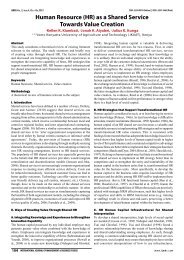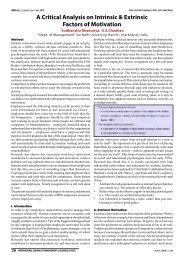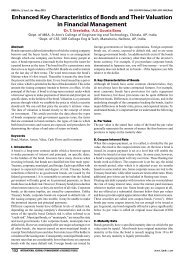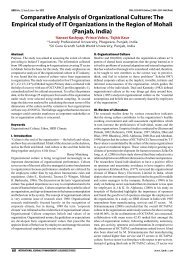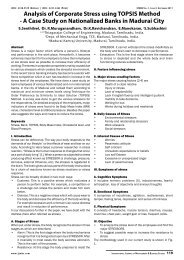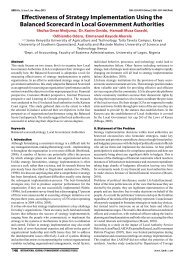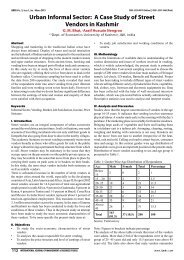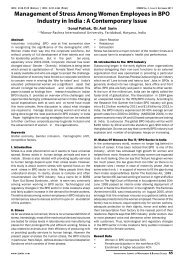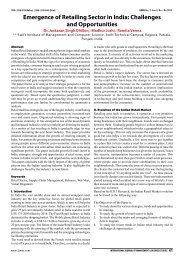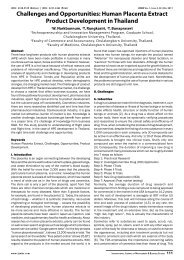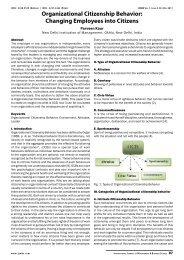Fundamental Ingredients Underpinning the Success of ... - Ijmbs.com
Fundamental Ingredients Underpinning the Success of ... - Ijmbs.com
Fundamental Ingredients Underpinning the Success of ... - Ijmbs.com
You also want an ePaper? Increase the reach of your titles
YUMPU automatically turns print PDFs into web optimized ePapers that Google loves.
IJMBS Vo l . 3, Is s u e 3, Ju l y - Se p t 2013ISSN : 2230-9519 (Online) | ISSN : 2230-2463 (Print)<strong>Fundamental</strong> <strong>Ingredients</strong> <strong>Underpinning</strong> <strong>the</strong> <strong>Success</strong> <strong>of</strong>Business Organizations Towards SustainableCompetitiveness: A Theoretical Review1 Benoit Katula, 2 Headmound Okari Isoe, 3 Ibrahim Moiro Omari1Ph.D Student: Boston University2,3Ph.D Candidate: Jomo Kenyatta University <strong>of</strong> Agriculture and Technology (JKUAT), Nairobi KenyaAbstractWith myriad opportunities and threats in <strong>the</strong> current dynamicbusiness environment, organizations are <strong>com</strong>peting to outdo eacho<strong>the</strong>r and secure leading positions in <strong>the</strong>ir respective industries.This paper made an attempt to bring out <strong>com</strong>mon fundamentalcharacteristics <strong>of</strong> top organizations in various industries thatendow <strong>the</strong>m with a <strong>com</strong>petitive edge above o<strong>the</strong>r players in<strong>the</strong>ir respective industries. This review presents <strong>the</strong>oretical andempirical findings as documented by various management scholarsand researchers in peer reviewed journals and o<strong>the</strong>r scholarlypublications in strategic management. From <strong>the</strong> <strong>the</strong>oretical andempirical literature ga<strong>the</strong>red, <strong>the</strong> paper concludes that in <strong>the</strong>contemporary business environment, successful and leadingbusiness organizations have invested substantially in technologicalinnovation, human resource development and participation, newproduct development, winning marketing strategies and corporatesocial responsibility.KeywordsBusiness <strong>Success</strong>, Sustainable Competitiveness, IndustryI. IntroductionAll forms <strong>of</strong> organizations in both public and private sectorhave been face multiple challenges emanating globalization,liberalization, technological advancements, and changingcustomers’ technological-driven expectations (Das, 1995; Kotlerand Armstrong, 2010; Letangulle and Letting, 2012). Organizationsoperate in a dynamic business environment that is technologicallydriven, globally unbounded, and customer oriented. Thesechallenges, among o<strong>the</strong>rs, call for extensive search and adoption <strong>of</strong>suitable strategies that can not only ensure growth and survival in<strong>the</strong> turbulent environment but also position business organizationsabove <strong>com</strong>petitors in <strong>the</strong> industry.Environmental forces largely influence <strong>com</strong>petition within anindustry especially those related to technology, economic forcessocial cultural values, market dynamics, products, political andlegal. Business <strong>com</strong>petition be<strong>com</strong>e even stiffer and <strong>com</strong>plex if<strong>the</strong> style <strong>of</strong> business is almost rigid, <strong>the</strong>reby giving <strong>the</strong> players alittle chance to diversify and play differently (Stalk et al.; Das,1995).With <strong>the</strong> advent <strong>of</strong> liberalization, and entry into <strong>the</strong> industry <strong>of</strong>new players, <strong>com</strong>petition among <strong>the</strong> various players has be<strong>com</strong>e sostiff that only those <strong>com</strong>panies with <strong>the</strong> best strategies are able tosurvive and position <strong>the</strong>mselves <strong>com</strong>petitively in <strong>the</strong> industry.This paper, is an attempt to review and ga<strong>the</strong>r <strong>the</strong> various <strong>com</strong>monattributes that define best performing business organizations.The paper contends that Leading organizations in most businessindustries are those that have invested in among o<strong>the</strong>r factors;technological innovation, human resource development andparticipation, new product development, winning marketingstrategies and corporate social responsibilityII. Guiding Theory and ModelThis review is guided by <strong>the</strong> Resource-based <strong>the</strong>ory (RBT) init’s analysis <strong>of</strong> fundamental ingredients underpinning <strong>the</strong> success<strong>of</strong> business organizations towards sustainable <strong>com</strong>petiveness.The RBT distinguishes organizations in terms <strong>of</strong> <strong>the</strong>ir strategicand resource endowments and stresses <strong>the</strong> uniqueness <strong>of</strong> everyorganization. This approach assumes that an organization canuse superior resources and capabilities to modify <strong>the</strong> industrystructure and or change <strong>the</strong> rules <strong>of</strong> a <strong>com</strong>petitive game (Peteraf,1993). According to Stalk, et al. (1992) <strong>the</strong> key to success isno longer where a <strong>com</strong>pany chooses to <strong>com</strong>pete but how itsunique resources and capabilities dictate strategy and lead tosuccess. The RBT focuses on <strong>the</strong> internal resources, capabilitiesand core <strong>com</strong>petencies <strong>of</strong> an organization (Barney, 1991). The<strong>the</strong>ory advocates for building strategies on <strong>com</strong>petitiveness anduniqueness <strong>of</strong> an organization (Peteraf, 1993).Barney (1991) argues that a resource is strategic and <strong>the</strong>reforelikely to give a <strong>com</strong>pany a <strong>com</strong>petitive edge if it contains givenspecific characteristics which include; valuability meaning <strong>the</strong>capacity to increase <strong>the</strong> organizations’ effectiveness and efficiency,when <strong>the</strong> resource is rare and in high demand, inimitability andsubstitutability (not readily substituted). From <strong>the</strong> RBT perspective,an organization endowed with or that acquires resource(s) <strong>of</strong> <strong>the</strong>stated features stand a high chance to position itself as a leader inits industry <strong>of</strong> operation and it is most likely to succeed.RBT <strong>the</strong>ory classifies resources into three basic types which include;<strong>the</strong> tangible resources, intangible resources and organizationalcapabilities which Day (1994) defines as a <strong>com</strong>plex bundle <strong>of</strong>skills and collective learning, exercised through organizationalprocesses that ensure superior coordination <strong>of</strong> functional activitiesfor instance <strong>the</strong> human capital. All <strong>the</strong>se resources <strong>com</strong>binedwhen inherent in an organization form <strong>the</strong> unique capabilitiesthat underpin success and <strong>com</strong>petitiveness for any businessorganization.II. Porter’s Five Forces ModelsStrickland, et all (2010) postulate that <strong>the</strong> five forces hold <strong>the</strong> state<strong>of</strong> <strong>com</strong>petition in an industry to be a <strong>com</strong>posite <strong>of</strong> <strong>com</strong>petitivepressures operating in key areas <strong>of</strong> <strong>the</strong> overall market. The fiveforces include; Pressures associated with <strong>the</strong> market maneuveringfor customer patronage that goes on among rival sellers in <strong>the</strong>industry, Pressures associated with <strong>the</strong> threats <strong>of</strong> new entrants,Pressures from <strong>the</strong> attempts <strong>of</strong> <strong>com</strong>panies in o<strong>the</strong>r industriesto win buyers over to <strong>the</strong>ir own substitute products, Pressuresstemming from supplier bargaining power and suppliers sellercollaboration and finally, Pressures stemming from seller-buyerbargaining power and seller-buyer collaboration.With a clear understanding <strong>of</strong> where power lies, an organizationcan take advantage <strong>of</strong> a situation <strong>of</strong> strength, improve a situation <strong>of</strong>weakness, and avoid making wrong moves that may work againsta business organization or disadvantage it against its <strong>com</strong>petitors.Porter’s five forces model can be an important guide in <strong>the</strong> planningwww.ijmbs.<strong>com</strong> International Journal <strong>of</strong> Management & Business Studies 67
IJMBS Vo l . 3, Is s u e 3, Ju l y - Se p t 2013 ISSN : 2230-9519 (Online) | ISSN : 2231-2463 (Print)by top management especially those playing in a <strong>com</strong>petitiveindustry. The five forces framework provides useful insights into<strong>the</strong> forces at work within an industry or market environment <strong>of</strong> a<strong>com</strong>pany and could inform <strong>the</strong> nature <strong>of</strong> strategies to be adoptedin order to navigate <strong>the</strong> <strong>com</strong>petitive environment so as to havean edge over rivals.III. Technological InnovationGlobal Technological development has had a huge impact in <strong>the</strong>way businesses are conducted. Multiple business strategies havebeen victims <strong>of</strong> <strong>the</strong> rapid emergence <strong>of</strong> what Hill (2010) terms astechnological paradigm shifts. Business organizations have haddifficult times coping with <strong>the</strong> rapid emergence <strong>of</strong> technologicallyrelated paradigm shifts, both in terms <strong>of</strong> strategy formulationand execution, mainly due to <strong>the</strong> rapid base at which <strong>the</strong>se shiftsoccur. This implies that any organization that aspires to securea leading position in such a turbulent market environment musthave a clear technological innovation strategy.Technological paradigm shifts occur when new technologies <strong>com</strong>ealong that revolutionalize <strong>the</strong> structure <strong>of</strong> <strong>the</strong> industry, dramaticallyalters <strong>the</strong> nature <strong>of</strong> <strong>com</strong>petition, and require <strong>com</strong>panies to adoptnew strategies to survive (Hill 2010; Kim and Mauborne,1999). For instance, in Kenya, technological advancements in<strong>the</strong> mobile financial services have revolutionalized not only <strong>the</strong>tele<strong>com</strong>munication industry but also <strong>the</strong> banking sector. Banksand financial institutions that have been slow in embracingmobile money transfer technology have found <strong>the</strong>mselves ata disadvantaged end while first movers gained immensely byadopting mobile money transfer technology.Hill (2010) observes that technological paradigm shifts appearto be more likely to occur in an industry where one, or both, <strong>of</strong><strong>the</strong> following conditions are in place. One, when <strong>the</strong> establishedtechnology in <strong>the</strong> industry is mature and approaching or at its“natural limit” and second, when “disruptive technology” hasentered <strong>the</strong> market place and is taking root in niches that are poorlyserved. Technology is a major determinant in <strong>the</strong> ability to innovateand is viewed both as a major source <strong>of</strong> <strong>com</strong>petitive advantageand <strong>of</strong> new product innovation (Gunasekeran at al., 1996).Organizations that are able to <strong>com</strong>bine customer value andtechnological innovation are highly likelyto enjoy sustainablegrowth and pr<strong>of</strong>itability (Kim and Mauborne, 1999) and <strong>the</strong>refore<strong>the</strong> variations in performance among players in an industry may beexplained by <strong>the</strong> variation on <strong>the</strong> extent <strong>of</strong> adoption and deployment<strong>of</strong> innovative technologically driven products. Utterback andAbernathy, (2005) contend that <strong>the</strong> primary motivation <strong>of</strong>technological innovation is to assure <strong>the</strong> survival <strong>of</strong> <strong>the</strong> entityand achieving sustainable <strong>com</strong>petitive performance.According to Adam and Farber, (2000), technological innovationin <strong>the</strong> organizational context, may be linked to performance andgrowth through improvement in efficiency, productivity, quality,<strong>com</strong>petitive positioning and market share among o<strong>the</strong>rs. Thesefeatures fit to describe top organizations that have been knownto be leaders in <strong>the</strong>ir industries.IV. Human Resource Development and ParticipationStorey (2001) refers to human resource development as anapproach to employment management which seeks to achieve<strong>com</strong>petitive advantage through strategic development <strong>of</strong> ahighly capable workforce. Reilly and Pfeffer (2000) contendthat <strong>the</strong> quality <strong>of</strong> human resource is one <strong>of</strong> <strong>the</strong> most essentialdeterminants <strong>of</strong> organizational success that need to be taken intoconsideration. Quality in this case refers to sum total <strong>of</strong> skills,68 International Journal <strong>of</strong> Management & Business Studiesattitudes, capabilities, experiences and o<strong>the</strong>r characteristics <strong>of</strong> <strong>the</strong>people required by a specific task or position (Peng & Litteljohn,2001). These scholars, fur<strong>the</strong>r note that we do live in a world inwhich knowledge, intellectual capital, ra<strong>the</strong>r than physical capitalis increasingly important and we need smart people who can dogreat things to increase productivity, build new products andservices and do so even more quickly.Leading business organizations in various industries are thosethat have strongly subscribed to human resource empowermentand talent management. For instance, effectiveness <strong>of</strong> strategyimplementation is, at least in part, affected by <strong>the</strong> quality <strong>of</strong> peopleinvolved in <strong>the</strong> process <strong>of</strong> crafting and deployment <strong>of</strong> <strong>the</strong> strategy(Govindarajan, 1989). If an organization’s workforce has limitedcapacity, <strong>the</strong>n <strong>the</strong> chance <strong>of</strong> success <strong>of</strong> such an organization areslim. Such a workforce will not take <strong>the</strong> lead in developing andnurturing an innovation culture, establishing innovation processand pushing <strong>the</strong> alignment between innovation strategy andbusiness strategy.Harrington (2006) observes that a high level in total organizationalinvolvement by all cadres <strong>of</strong> management during strategyimplementation has a positive effect on <strong>the</strong> level <strong>of</strong> implementationsuccess. The “who” <strong>of</strong> strategy implementation at differenthierarchical levels will for instance include top level management,middle level management, and <strong>the</strong> lower level management all<strong>of</strong> whose participation determine <strong>the</strong> success level <strong>of</strong> strategyimplementation (Heracleous, 2000). Poloski and Vidovic (2007) inasserting <strong>the</strong> strategic role <strong>of</strong> human resource in an organization henotes that HRM in a modern organization has two main interrelatedroles which include; to foster <strong>the</strong> performance <strong>of</strong> an organization,and to act as a support for achieving <strong>com</strong>petitiveness throughpeople. It is <strong>the</strong>refore imperative that a leading organization musthave invested in human resource and development and accorded<strong>the</strong>m space for participation and talent exploitation hence a<strong>com</strong>petitive advantage over o<strong>the</strong>r industry players.V. New Product DevelopmentNew product development is <strong>the</strong> introduction <strong>of</strong> original productsor product improvement or modification, through an organization’sresearch and development initiatives (Cooper 2001; Kotler andArmstrong 2010). According to cooper (2001), new productdevelopment is one <strong>of</strong> <strong>the</strong> most critical strategies in any <strong>com</strong>petitiveindustry. In <strong>the</strong> current business environment, organizations haveto deal with a dynamic environment within which innovation andcreativity are vital <strong>com</strong>petencies. Organizations need to keep aconstant flow <strong>of</strong> new ideas in order to enjoy <strong>com</strong>petitive advantageand sustain customer patronage (Mathisen and Einarsen, 2004).In emphasizing <strong>the</strong> role <strong>of</strong> product development as a source <strong>of</strong>survival and <strong>com</strong>petitive advantage in an industry, Hoyer, etal. (2010) narrates that to grow, it has be<strong>com</strong>e necessary fororganizations to evolve new products that reflect <strong>the</strong>ir customeror target market.Today’s customer is highly informed and more demandingthan before. Responsiveness and agility to customer need andchange <strong>of</strong> market conditions have be<strong>com</strong>e key determinants <strong>of</strong>an organization’s success and call for enhanced capacity for anorganization to introduce new products <strong>of</strong>ten (Robertson and Yu,2003). The already stated development <strong>of</strong> mobile money transferin Kenya illustrates a typical example <strong>of</strong> new product developmentin which <strong>the</strong> Mpesa mobile money transfer product <strong>of</strong> Safari<strong>com</strong>Company received immense popularity in <strong>the</strong> Kenyan marketsuch that its spread and influence radically changed <strong>the</strong> rules <strong>of</strong><strong>the</strong>. This development has led to <strong>the</strong> introduction <strong>of</strong> more newwww.ijmbs.<strong>com</strong>
ISSN : 2230-9519 (Online) | ISSN : 2230-2463 (Print)products around <strong>the</strong> mobile money transfer that has kept Safari<strong>com</strong>Company ahead <strong>of</strong> its peers.VI. Winning Marketing StrategyRobson (1997) defines marketing strategy as a pattern <strong>of</strong> resourceallocation or decisions made throughout an organization whichrelate to <strong>the</strong> customer or customer groups to attract and enhance <strong>the</strong>irloyalty to <strong>the</strong> <strong>com</strong>pany. A proper marketing strategy emanates froman extensive analysis <strong>of</strong> <strong>the</strong> market and its environment, customerbuying behavior, <strong>com</strong>petitive activities, and <strong>the</strong> abilities <strong>of</strong> <strong>the</strong>marketing intermediaries (Robson, 1997). According to Robert(2012), organizations are focused on designing various marketingstrategies that can be used in conquering a heavily <strong>com</strong>petitivemarket in order to attain a leadership in <strong>the</strong> industry.Companies are increasingly turning to <strong>the</strong>ir customers as a means<strong>of</strong> securing <strong>the</strong>ir <strong>com</strong>petitive edge. Therefore, CRM has be<strong>com</strong>e<strong>the</strong> mantra for success and developing close and sustainablerelationship is important for any organization <strong>the</strong> dreams <strong>of</strong> aleading position in an industry. Some <strong>of</strong> <strong>the</strong> main marketingstrategies adopted by leading industry players in different industriesin Kenya include, ingenious product innovation, product mix,product line advertising, promotion, pricing among o<strong>the</strong>rs.Belch and Belch (1997), also contend that any organizationthat wants to exchange its products or services in <strong>the</strong> marketplace successfully should have a strategic marketing plan toguide resource allocation and enable it <strong>com</strong>pete favorably. Theyfur<strong>the</strong>r emphasize that an important aspect <strong>of</strong> marketing strategydevelopment is <strong>the</strong> search for a <strong>com</strong>petitive advantage which canonly be attained through having quality products that <strong>com</strong>manda premium price, providing superior services, having <strong>the</strong> lowestproduction cost and dominating channels <strong>of</strong> distribution.Customer sustainability is <strong>the</strong> bloodstream that nourishes everybusiness and leading organizations have mastered <strong>the</strong> art andinvested significantly in <strong>the</strong> management <strong>of</strong> customer. Accordingto Agrawal (2003), service markets need to build up long-termrelationships with <strong>the</strong>ir customers by understating <strong>the</strong> cause behind<strong>the</strong>ir problems and provide products that provide solutions to<strong>the</strong>m. With fierce <strong>com</strong>petition in almost every industry, businessplayers must find ways <strong>of</strong> reducing prices, attract new customerswhile jealously guarding <strong>the</strong> existing one from existing to o<strong>the</strong>rplayers and find ways <strong>of</strong> increasing <strong>the</strong>ir pr<strong>of</strong>its for growth andsurvival.VII. Corporate Social ResponsibilityCSR is a concept in which <strong>com</strong>panies integrate social andenvironmental concerns in <strong>the</strong>ir businesses operations and in<strong>the</strong>ir interaction with <strong>the</strong>ir stakeholders on a voluntary basis(European Commision’s Directorate – General for Employmentand Social Affairs). Carroll (1979), views CSR as en<strong>com</strong>passing<strong>the</strong> economic, legal, ethical, and discretionary expectations thatsociety has <strong>of</strong> organizations at a given point in time. There hasbeen a strong debate if CSR has any long term added value tobusiness organizations or if it erodes gain made by businessorganizations to <strong>the</strong> disadvantage <strong>of</strong> its stockholder. Antagoniststo CSR mainly argue on <strong>the</strong> basis that <strong>the</strong> “business <strong>of</strong> businessis business”. However, <strong>the</strong> main weakness <strong>of</strong> some <strong>of</strong> <strong>the</strong>searguments against CSR is that <strong>the</strong>y all focus on <strong>the</strong> tension betweenbusiness and society ra<strong>the</strong>r than on <strong>the</strong>ir interdependence and<strong>com</strong>plimentarily.Many organizations according to Porter (2006) cannot make aclose link between <strong>the</strong>ir core strategy and <strong>the</strong> CSR activities. Thisaccording to Porter results to a hodgepodge <strong>of</strong> uncoordinated CSRIJMBS Vo l . 3, Is s u e 3, Ju l y - Se p t 2013and philanthropic activities disconnected from <strong>the</strong> <strong>com</strong>pany’sstrategy that nei<strong>the</strong>r make any meaningful social impact norstreng<strong>the</strong>n <strong>the</strong> firms’ long-term <strong>com</strong>petitiveness. Galbreath (2006),argues that most <strong>com</strong>pany strategists address what <strong>the</strong> firms mightand can do as well as what <strong>the</strong> firm wants to do but <strong>the</strong>y fail t<strong>of</strong>ocus on what a firm oath to do. The oath to do is what should entailCSR. By targeting CSR towards specific stakeholders, <strong>the</strong> goalis to increase long-term value creation for <strong>the</strong>se stakeholders aswell as for a firms’ financial and reputation position in <strong>the</strong> marketand in <strong>the</strong> long run accord <strong>the</strong> <strong>com</strong>pany <strong>the</strong> desired <strong>com</strong>petitiveadvantage within <strong>the</strong> industry and beyond.Proponents <strong>of</strong> CSR have used four arguments to make <strong>the</strong>ir case;moral obligation, sustainability, license to operate and reputation.Porter (2006) summarizes that business organizations shouldoperate in ways that secure long-term economic performance byavoiding short term behavior that might be socially detrimentalor environmentally wasteful. An influential opinion advanced byClarkson (1995) argues that <strong>the</strong> economic and social purpose <strong>of</strong><strong>the</strong> corporation is to create and distribute increased wealth andvalue to all its primary stakeholders groups, without favoring onegroup at <strong>the</strong> expense <strong>of</strong> <strong>the</strong> o<strong>the</strong>rs. Top organizations that havesucceeded are those that have adequately addressed and aligned<strong>the</strong>ir strategy on what <strong>the</strong> firm might and can do with what <strong>the</strong>firm oath to do.VIII. Discussion and ConclusionThis paper has focused in presenting some <strong>of</strong> <strong>the</strong> top ‘trending’fundamental ingredients underpinning <strong>the</strong> success and<strong>com</strong>petitiveness <strong>of</strong> leading business players. The paper begunby appreciating innumerable inherent opportunities and threatsthat drive and define <strong>the</strong> current business environment that isdynamic and turbulent.The paper aimed at analyzing important elements that characterizetop organizations in various sectors and what makes <strong>the</strong>seorganizations to be above o<strong>the</strong>r players in <strong>the</strong>ir industries. From <strong>the</strong>discussion presented, it emerged that key elements that constitute<strong>the</strong> basis <strong>of</strong> <strong>com</strong>petitive advantage <strong>of</strong> leading organizations are;technological innovation, human resource development andparticipation, new product development, winning marketingstrategy and investing in corporate social responsibility. Theseelements, according to this review are <strong>the</strong> key ingredients thatendow top performing organizations with not only success and a<strong>com</strong>petitive advantage but also leading positions in <strong>the</strong>ir industries.The paper concludes that <strong>the</strong> recipe for <strong>Success</strong>ful Businessorganization and leading position in an Industry constitute;Technological Innovation + Human Resource Development andParticipation + New Product Development + Winning MarketingStrategies + Corporate Social Responsibility.References[1] Adam, M., Farber, A., Khallil, T,,"Financing TechnologicalInnovation. Management <strong>of</strong> Technology II", Institute <strong>of</strong>Industrial Engineers. USA, 2000.[2] Agrawal, L.,"Make a Mistake and Deepen RelationshipMapping Customer Relationships After Service Recovery",New Delhi. Excell Books, 2003.[3] Barney, J.,"Firm Resources and Sustainable CompetitiveAdvantage", Journal <strong>of</strong> Management, 17(1), 1991.[4] Belch, E., Belch, A.,"Advertising and Promotion", AnIntergrated Marketing Perspective. McGraw Hill Inc.,1997.www.ijmbs.<strong>com</strong> International Journal <strong>of</strong> Management & Business Studies 69




